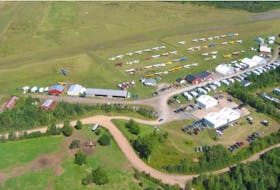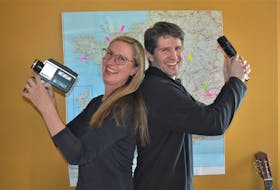Burntcoat Head’s coastline is vast and vibrant. The red hues make its cliff look like a sunset is shining on it constantly. The bright shamrock colour of the sea lettuce contrasts with the red ocean floor, while the knotted wrack resembles grapes slowly turning into raisins. An endless amount of black periwinkle gastropods and white moon snails speckle the sand for miles.
Clusters of people walk on the ocean floor, watching every step so as not to crush a sea critter. If you find the right piece of leafy bryozoan, it will smell like a freshly cut lemon. Small tidal pools soak up the sun’s rays and warm the water, until the cold ocean returns in a few hours when the tide rises. Snails slowly dance on wet hands as tourists watch in amazement at what the ocean’s residents can do. The crisp, salted air would give some Nova Scotians the feeling of home.
Burntcoat Head Park is in Noel, about 88 kilometres from Halifax by Highway 102. The drive takes about an hour and a half, with many cows and sheep to see along the way.

Anita Benedict, lead interpretive guide at the park, says Burntcoat Head’s name is something she gets asked about constantly. It has a few origin stories: a coat hung too close to a marsh fire or a ship’s crewman getting too close to a fire and yelling “Burnt coat!” But it’s believed it’s most likely from “an English pronunciation of Pointe Cloche,” French for Bell Point because of a church built nearby. Likely it came from the Acadians in the early 1700s.
During the tour, staff tell the Glooscap legend. which is how the Mi’kmaq explained the Annapolis Valley’s existence, including Burntcoat Head. According to the story, Glooscap turned himself into a beaver and slapped his tail so hard that he created the five islands in the Bay of Fundy.
“The older I get, the more I believe [the Mi’kmaq people] were on to something,” said Benedict.
The park is equipped with a lighthouse that has a short, square tower, unlike the iconic tall shape that’s more recognizable. The original building was torn down in 1913 because the cliff’s erosion made it difficult to get to. They’ve had three lighthouses built at Burntcoat Head, with the third and current opening in 1995.
The coastline fights with currents to stay intact and is slowly eroded over time. The tide rises to an average of 46 feet (14 metres) and with an extreme height of 51 feet (15.5 metres). Tides will come in to the coastline at an average on an inch per minute.
“The cliff can change every day,” said Benedict, “And it just makes you feel so small.”
She said one day a family was having a picnic close to the coastline. In the following week, the overhead near where they were eating collapsed. For that reason, tours stay away from the cliffs to be safe. Benedict wants visitors to explore as much as possible, but also to realize the park is a changing ecosystem. Visitors should be aware of what’s below their feet and above their heads.
Under rocks, hermit crabs and blue mussels can be found hanging out. Sea creatures that look like earwigs dance on the rock when they see the sun. After peeking at the sea animals, it’s important to gently and safely return them to their homes.


Burntcoat Head is home to a threatened species: the Atlantic Mud-piddock. Their shells look like another park resident, false angelwing. Mud-piddocks are less than five centimetres long.
An East Hants town crier, Benedict’s booming voice warns park visitors when they’re in restricted areas where the mud-piddocks are concentrated. The restricted areas are necessary because the slightest pressure can damage the mud-piddocks’ homes. They bury themselves into the ocean floor rocks and stay there for an average of 14 years. The white-shelled creatures are attracted to the warm water in the small tidal pools, making it important to stay out of them to keep their homes intact.

Benedict recommends Walton’s Pub when visitors ask where to eat. The pub has the Walton Whopper and claims to have served just under a billion. It's decorated with antique furniture, including an organ. Big food portions are easy to split with a friend.
Visitors to Burntcoat Head can take their experience to the next level by having dinner on the ocean floor. Diners spend six hours on the ocean floor. For $950 per couple, the Flying Apron will treat you to lunch and a three-course dinner. Dining visitors will also explore the coastline between meals during a private tour with park staff. (The experience is sold out for this year.)
Benedict says the park is most popular with seniors but it could suit kids who have a curiosity for the ocean and little creatures. If you go, it’s important to be safe and aware of the tide schedule. Visitors should also bring sunscreen, boots and a sense of adventure.








